To ease the pressure on HDFC Bank and HDFC, the Reserve Bank of India (RBI) has allowed the bank to gradually meet priority sector loan requirements for up to three years after its merger with HDFC.
The RBI said that adjusted net bank credit could be calculated considering one-third of HDFC’s outstanding loans at the effective date of the first year of consolidation. The lender informed the exchange on Friday that the remaining two-thirds of HDFC’s portfolio will be considered equally over the next two years.
Under current rules, banking entities must lend 40% of adjusted net bank credit to so-called priority sectors or economically vulnerable sectors such as agriculture, microenterprises and other economically weak sectors.
However, HDFC Bank must comply with the regulatory requirements of Cash Reserve Ratio (CRR), Statutory Liquidity Ratio (SLR) and Liquidity Coverage Ratio (LCR) without exception after the merger of HDFC. Analysts believe that could hit profits in the combined entity’s first year of operations. Currently, the SLR is 18%, and the CRR is 4.5%.
In announcing the HDFC twin merger in April last year, HDFC chairman Deepak Parekh said that HDFC Bank had asked the Reserve Bank to adopt a phased approach to SLR and CRR, priority sector loans and grandfathering of certain assets and liabilities in respect of some of its subsidiaries.
“HDFC Bank shall continue to comply with the prevailing requirements of the CRR, SLR and LCR from the effective date, without exception,” according to the exchange filing.
On Friday, the markets regulator Securities and Exchange Board of India (Sebi), approved a proposal to change the controlling stake of HDFC AMC to HDFC Bank as part of the merger plan.
Dubbed the biggest deal in Indian corporate history, HDFC Bank agreed to take over the largest housing finance company on April 4, 2022. Six regulators must approve the deal. These include RBI, Sebi, IRDAI, PFRDA, CCI and NCLT.
Among other measures, the RBI has allowed investments, including subsidiaries and associates of HDFC, to continue as investments of HDFC Bank. It also enables HDFC Bank or HDFC to increase its shareholding in HDFC Life Insurance Company and HDFC ERGO General Insurance Company to more than 50% before the effective date.
In addition, the RBI has allowed HDFC Bank to continue holding shares in HDFC Private HDFC Education and Development Services for two years from the Effective Date, and HDFC Credila Financial Services, subject to reducing the shareholding within two years to 10% from the effective date without accepting any new clients.
HDFC Bank will also conduct a one-time mapping of all borrowers of HDFC to set the base rate and spread. The bank said all retail, MSME and other floating-rate loans approved by HDFC would be linked to the appropriate benchmark within six months from the effective date.
Asked whether he would increase interest rates on existing home loans for HDFC customers, HDFC Bank Chief Financial Officer Srinivasan Vaidyanathan said: “Anytime we think from the customer’s point of view, the interest rate must not hurt the current. Otherwise, the customer can withdraw and refinance anywhere else. So that will be competing for customers, and our goal is to continue that relationship and move forward.”
Also, “based on the list filed by HDFC, RBI has allowed promoter donations/equity loans over Rs 20 lakh to individuals to continue within its existing tenure/term,” the bank said.
After the effective date, asset classification of accounts in HDFC Bank’s books will be done following the norms applicable to banks, the bank added. Banks may seek clarification from the RBI on the letter dated April 20, 2023. The bank will also provide the RBI with the specific amount of liabilities as of the effective date. The merger is expected to close in July 2023.



